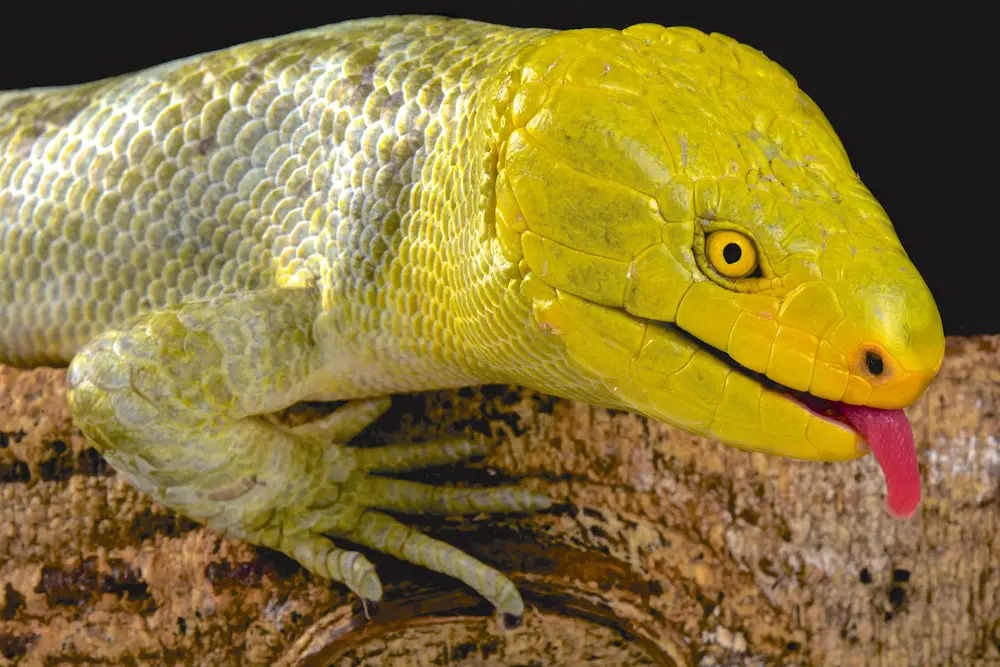In this Monkey Tailed Skink Care guide, we’ll be looking at how to keep what is quite possibly the world’s most unique skink species…
Last updated on May 13th, 2023 at 05:49 pm
Monkey Tailed Skinks are a unique lizard breed that needs special care to remain healthy and active. This comprehensive guide covers everything from nutrition, housing, and handling, to common health issues they may experience. We’ll provide valuable insight into how best to keep these creatures happy and thriving in a home environment.
Monkey tailed skink range and facts
This species is weird, wonderful, and 100% unique. It’s the largest species of skink in the world, and also happens to be one of the only species to have a prehensile tail, hence its other common name: the Solomon Islands Prehensile Tailed Skink.
Here’s some other quick facts that you might find surprising:
| Scientific name: | Corucia zebrata |
| Subspecies: | Northern Monkey Tailed Skink (Corucia zebrata alfredschmidti) Common Monkey Tailed Skink (Corucia zebrata zebrata) |
| Range: | Solomon Island (Papua New Guinea) |
| Preferred habitat: | Forest with a high canopy |
| Size: | 24-32inches (60-81cm) |
| Niche: | Arboreal |
| Activity rythm: | Crespuscular/nocturnal |
| Reproductive method: | Viviparous, single offspring or occasionally twins |
| Social behavior: | Social, living in small groups |
| Diet: | Herbivorous |
| Care level: | Medium (but expensive!) |

Housing
As large, arboreal lizards, both subspecies of Monkey Tailed Skink require very large enclosures. You CANNOT keep one happy in a regular vivarium or glass tank.
Moreover, this species is social, living in small groups of one male and two or three females. They have a clear need for socialization, and this website does not recommend ever keeping one alone. This obviously means you should count on getting two – all the better!
A pair of Monkey Tailed Skinks requires an enclosure size of 5-6 feet long x 2-3 feet deep x 4-6 feet high. This is relatively large, it is important to note that the species’ need for a higher humidity level may be difficult to keep these levels consistently high.
Keeping their environment as natural as possible while creating plenty of hiding spots is recommended. When adding branches, try to include a least two that are perpendicular to the ground (horizontal). These make nice resting places where the lizards can feel safe because they’re above the ground, without having to hang on constantly.
Substrate
Substrate isn’t hugely important for this species. After all, I’ve only seen them on the ground when people have placed food for them down there. It just needs to do one thing: maintain humidity.
You could use any reptile-safe substrate, and really your choice comes down to what you find the most esthetically pleasing. Acceptable options include:
- Cypress mulch
- Orchid bark
- Coco coir (ie Eco Earth)
- Coco chips
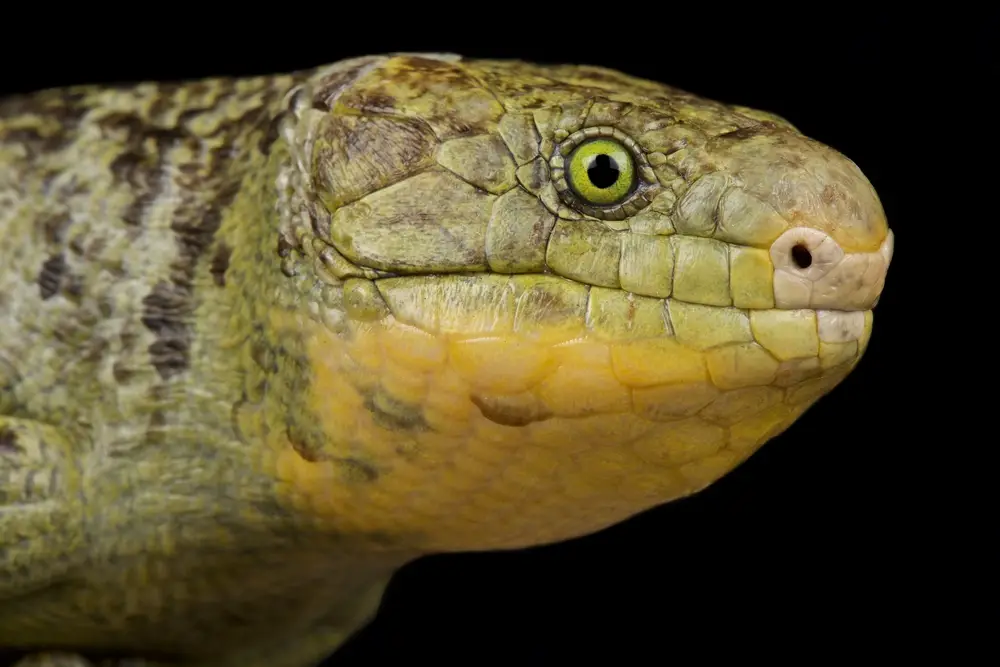
Temperature
The Monkey-tailed skink is a unique lizard species, and its temperature environment must be carefully managed to ensure it remains healthy. The main thing to remember is that they come from a really, really nice climate zone!
Most of the equatorial islands they inhabitat have a warm climate, moderated by sea breezes. It never gets too hot or too cold. So, in captivity that’s what you need to replicate.
During the day, temperatures should range from 80 to 85F, whereas in the evening, they can dip as low as the mid-70s. Straying too far from this range will result in illness. As with any reptile, there should be a thermal gradient, with a cooler part of the enclosure they can retire to if they get too hot.
The best methods for heating them are a heat bulb or a ceramic heat emitter. Whatever you go for, it must be outside of the cage, or inside a protective guard to prevent your skink from burning itself.
A heat bulb can be either halogen or mercury vapor, depending on whether you use a separate UV bulb (mercury vapor is an all-in-one option). If, on the other, hand you opt for a ceramic emitter, this can also provide nighttime warmth if your house regularly drops below 75F at night. In that case, you’d need a pulse-proportional thermostat that also has a nighttime setting.
Lighting
Being equatorial, Monkey Tailed Skinks need 12 hours of light, all year round. This is vital to the functioning of their metabolism and overall health.
Being largely crepuscular, they also seem to benefit from exposure to mid-range UVB lighting. 5.0 UVB bulbs are the best option, and you can find more information on this by checking out Zoomed’s guide: choosing the correct UVB lamp.
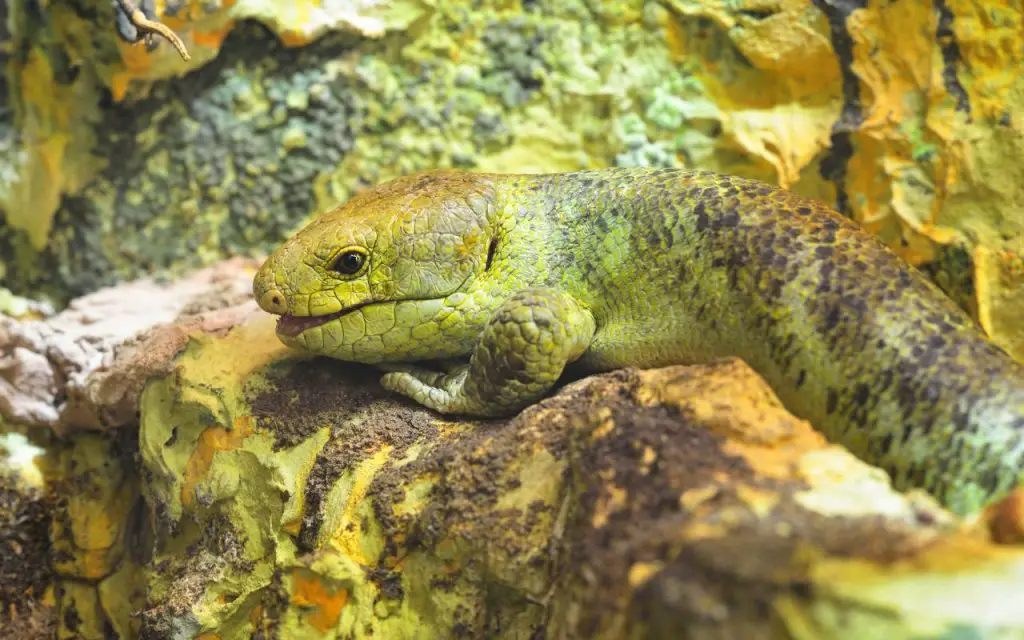
Humidity and water
As tropical forest lizards, Monkey Tail Skinks thrive in an environment where humidity is consistently between 70 and 80%. You can achieve this by spraying them twice a day, or once a day, depending how good their enclosure is at holding humidity.
Additionally, always have a hygrometer placed somewhere in the enclosure. It doesn’t have to an expensive one, just one that is accurate enough to show when humidity levels are dropping. I still use the analog ones for some of my pets, and whenever they say “high”, you know humidity is up at the 70% level or more.
Though setting up proper misting schedules and monitoring humidity can be time-consuming, it can go a long way to preventing illness and difficult shedding.
For water, always provide a shallow but sturdy dish of clean water in the bottom of the enclosure. Additionally, try to place small dishes of water in higher parts of the enclosure.
What do Monkey tailed skinks eat?
Regarding their dietary needs, they are herbivores, meaning they feed mainly on leaves, fruits, and flowers in the wild. This makes feeding them a little more labor intensive than feeding a Leopard Gecko, for example.
To stay healthy, they must eat a variety of green vegetables, and a little fruit on a regular basis. DO NOT feed them Iceberg Lettuce – it has almost zero nutritional content. Suitable foods include:
- Pothos leaves
- Dandelion greens
- Figs
- Turnip
- Mustard greens
- Watermelon
- Hibiscus flowers
To help balance things out, you can also provide a formulated dietary product. The best one I’ve seen so far is Repashy Grassland Grazer, which packs in a lot of highly nutritious ingredients.
As far as supplementation goes, approach it pretty much the say way you would a Fat-tailed Gecko or Leopard Gecko. Give calcium supplementation once a week, and vitamin supplementation once a week. Remember: The calcium supplement should not include D3 if you are providing UVB lighting for your skink.

Handling and temperament
Every Monkey Tailed Skink I’ve handled has been gentle, slow-moving, and calm. This is a little misleading, however, because they actually get stressed out quite easily. In fact, some of them start out defensive when you first get them. They also get defensive when they have a young baby.
The best approach is to give them time to adjust to your presence, and slowly give them opportunities to come out of the enclosure and meet you. With patience, they eventually become curious, friendly pets that will climb around on your arms or shoulders.
Do Skinks Recognize Their Owners?
Interestingly, Monkey Tailed Skinks have been known to recognize their owners over time. Particularly if they are regularly handled, socialized, and provided physical and mental enrichment.
While skinks won’t necessarily come running up to their owner like a dog would or show affection in traditional ways, they can bond with the lucky humans who care for them. In rare instances, this species has even bonded with other pets, like parrots.
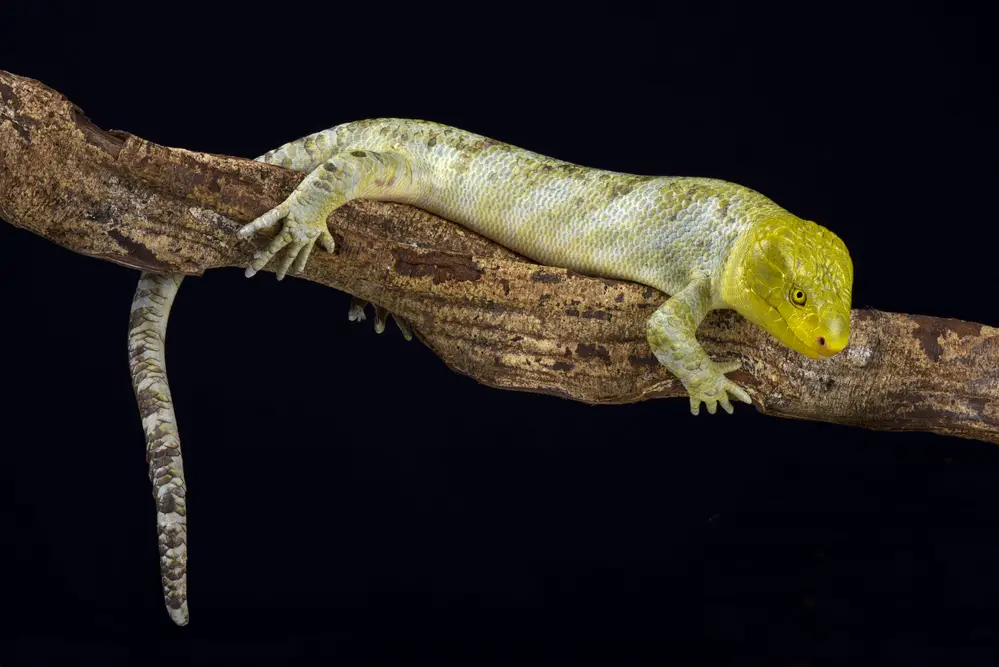
Common health problems
Monkey Tailed Skinks are susceptible to all the common reptiles diseases if their temperature, humidity, diet, and hygiene needs are not met. These include:
- metabolic bone disease
- anorexia
- skin infections (scale rot/dermatitis)
- respiratory infections
- vitamin deficiencies
- mouth rot (stomatitis)
All of these conditions are 100% preventable, of course. Pay close attention to their care, day after day, and chances are you will never have to deal with any of them. As with any herbivorous reptile, be extra attentive to providing a varied diet.
How long does a prehensile-tailed skink live?
With proper care and a balanced diet, prehensile-tailed skinks can live up to an impressive 25 to 30 years! That said, many only live to around 10-15 in captivity. Clearly it takes a little work to achieve a 20+ lifespan for this species.
In my opinion, the main thing to keep in mind with herbivores like this is that they need a varied diet every single day. That means providing it day after day, month after month, year after year.

Monkey tailed skink for sale
To it putly simply, Morphmarket.com is the best place to find one of these skinks for sale. That said, there’s two options available: wild-caught or captive-bred.
Wild-caught individuals cost around $700-900. They have generally suffered immense stress during shipment, and many of them die within a few months of purchase (or less).
Captive-bred individuals, on the other hand, are socialised, and generally healthy and happy. They might be with you for another 20 years. They usually cost at least $1500-1700, but if you’ve got it, they’re worth it.
Why Are Monkey Tailed Skinks So Expensive?
Monkey tailed skinks are highly sought after due to their rarity and unique appearance. Native only to the Solomon Islands, they make an exotic addition to any pet collection.
The main reason for their high price, though, is their low reproductive yield. They give live birth, and may gestate for as long as eight months. When they do finally give birth, it’s to one baby, or very occasionally two. This makes breeding them slow, and keeps demand higher than supply.
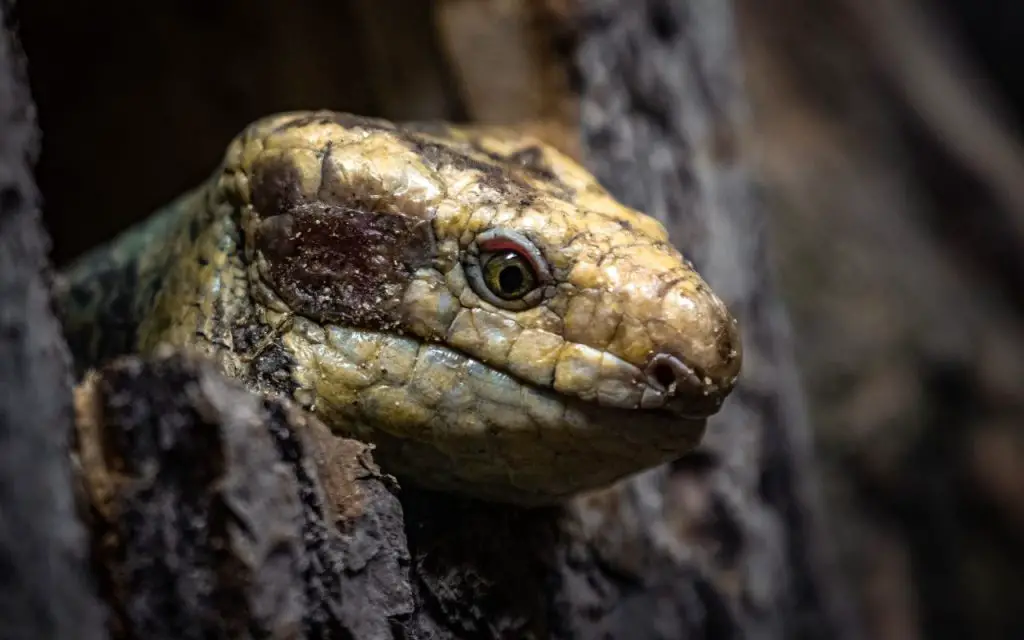
The bottom line
This is a big, expensive lizard that requires a large enclosure and consistent care. It is also species that thrives in small groups, and may become lonely on its own.
Instead of thinking of them like a regular reptile, you must think of them as an animal that has convergently evolved a social structure similar to that of some small primates.
Don’t get me wrong, they are amazing pets and well worth your time. But be prepared – the initial cost of getting them setup is high, as is the purchase price of the animals themselves.
If you’re ok with this, and have time to prepare a mix of veggies for them every day, then they will reward you with fascinating behavior and a temperament that only gets better over time.
Care Summary
| Temperature: | 80-85F during the day, 75F at night |
| Humidity: | 70-80% at all times |
| Favourite food: | Leafy greens |
| Enclosure size: | 5-6 feet long x 2-3 feet deep x 4-6 feet high |
| Lighting needs: | UV light beneficial, 12 hours daily |
| Availability: | Very low |
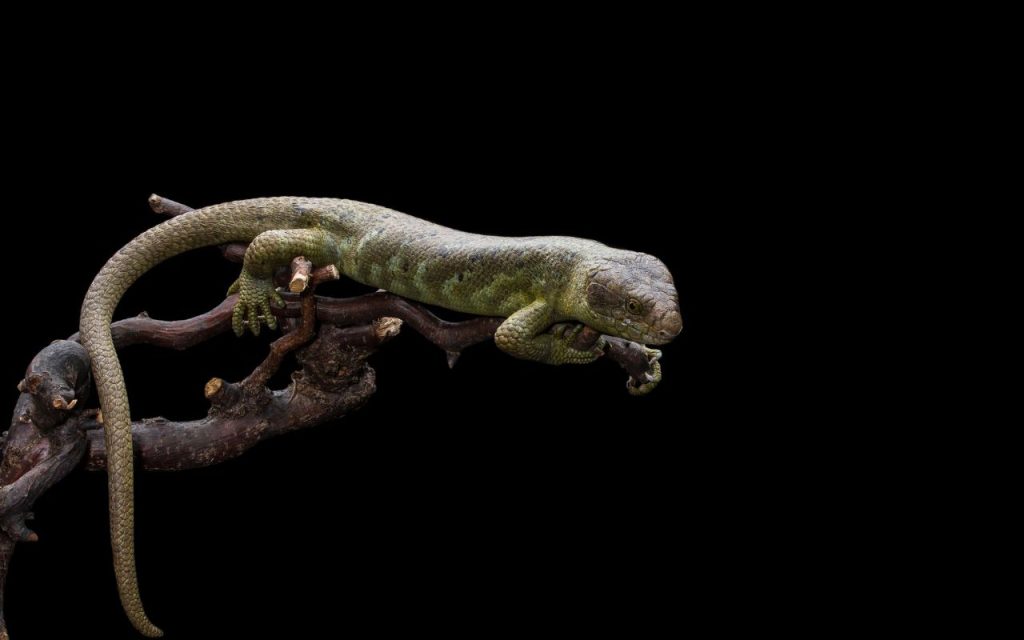
FAQ relating to Monkey Tailed Skink Care Sheet
Before you go, take a quick look at some of the more commonly asked questions regarding the care of this species…
Are skinks high maintenance?
Most skinks are not high maintenance. Nonetheless, Monkey Tailed Skinks require close attention to their humidity levels and diet. This means they are higher maintenance than many more commonly kept species.
Do skinks need to be misted?
To maintain humidity at its optimal level of 70-80%, Monkey Tailed Skinks need misting once or twice daily, and humidity levels should be monitored with a hygrometer. This is vital to ensure that they remain healthy and will aid them in shedding their skin easier.
How often should I hold my skink?
It is important to create a safe and low-stress environment to ensure the well-being of your pet. Therefore, when first getting acquainted with your skink, it is best to limit initial handling sessions to ten minutes or less. Only do so if the lizard is already tame though, otherwise leave it alone until it decides to climb onto your arm of its own accord.
Do skinks need a heat lamp at night?
Monkey Tailed Skinks do not need a heat lamp at night. The light would disturb them, after all. If you do find that your house drops below 75F at night, then you can use a ceramic heat emitter on a thermostat to provide heat. Always use heating elements like this inside a proper wire guard to prevent burns.

